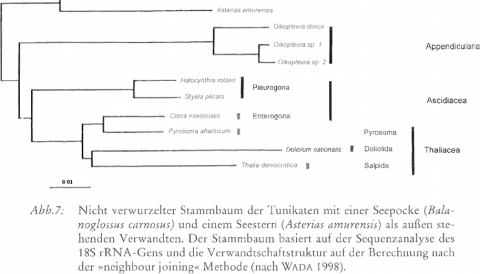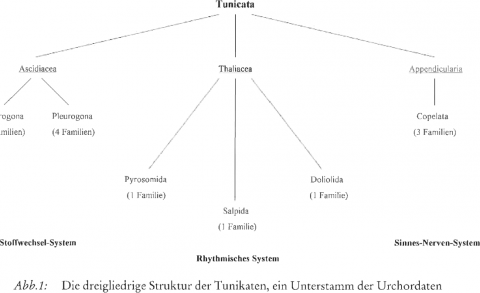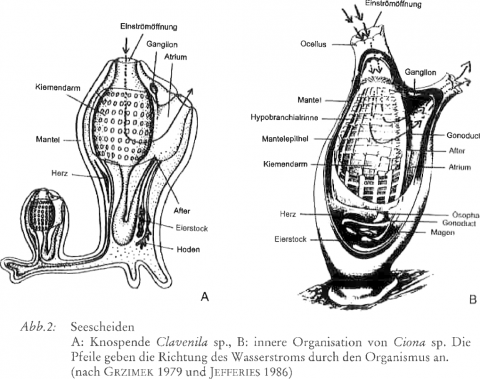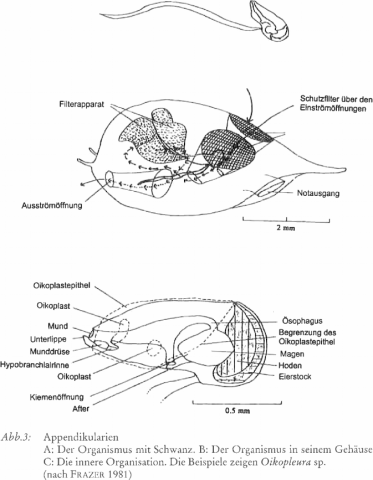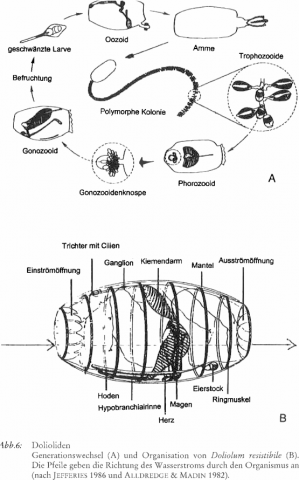Die Manteltiere (Tunikaten) Aspekte zu ihrer Dreigliederung
ARTIKELREFERENZ EXPORTIEREN
- Downloadkosten : €6
Zusammenfassung:
Die drei Klassen der nur im Meer vorkommenden zwittrigen Manteltiere oder Tuni«katen, die Appendikularien, Thaliaceen und Seescheiden (Ascidien), lassen in sich unter dem Gesichtspunkt der Dreigliederung in charakteristischcr Weise die Wirk«samkeit des Sinnes-Nerven-Systems, des rhythmischen Systems und des Stoffwechselsystems erkennen.
Seescheiden sind sessile Organismen mit einer kaulquappenartigen frei schwimmenden Larve, die sich aber auch vielfach rein vegetativ durch Knospung vermehren. In ihnen zeigt sich insbesondere das Stoffwechselsystem wirksam und am wenigsten das Sinnes-Nerven-System. Das wird auch dadurch deutlich, dass die in der Larve ausgebildete Chorda dorsalis, das Neuralrohr und die metamere Muskulatur in der ausgewachsenen Seescheide wieder vollständig resorbiert werden.
Appendikularien als die kleinsten und rein pelagisch lebenden Manteltiere behalten ihr ganzes Leben über die kaulquappenartige Form und die Chorda dorsalis, das Neurahlrohr und die metamere Muskulatur bei. Sie vermehren sich nur geschlechtlich, haben sogar eine getrennt geschlechtliche Art und sind die nachweislich ältesten Manteltiere. In ihnen dominiert das Sinnes-Nerven-System.
Thaliaceen zeichnen sich durch einen obligaten Generationswechsel aus und entwickeln bis auf eine Ausnahme kein Larvenstadium. Bei ihnen lassen sich viele Merkmale und Eigenschaften finden, welche die starke Betonung des Rhythmischen und die zwischen den beiden anderen Klassen vermittelnde Stellung der Thaliaceen zeigen. In den drei Ordnungen der Thaliaceen, den Feuerwalzen, Salpen und Dolioliden, sind Charakteristika der Manteltiere und der Generationswechsel jeweils so abgewandelt, dass sich darin eine Steigerung im Goetheschen Sinne manifestiert, die viele Charakteristika aller drei Manteltierklassen und insbesondere der Appendikularien und Seescheiden vermittelnd aufgreift. Die Dreigliederung spiegelt sich auch in Sprechender Weise in der Entwicklungsgeschichte der Manteltiere wider.
Referenzen
- ALLDREDGE, A. L. (1976): Appendicularians. Sci. Amer. 235: 94-102
- ALLDREDGE, A. L. (1984): The quantitative significance of gelatinous zooplankton as pelagic mers. In: Fasham, M. J. R. (Edit), Flows of Energy and Materials in ] Ecosystems. Plenum Publ., pp. 407-433. New York
- ALLDREDGE, A. L. & MADIN, L. P. (1982): Pelagic tunicates: unique herbiv the marinc plankton. BioScience 32: 655-663
- ALLDREDGE, A. L. & SILVER, M. L. (1988): Characteristics, dynamics and sigr ce of marine snow. Prog. Oceanogr. 20: 41-82 BAK, R. P. M., JOENJE, M., DE ]ONG, l., LAMBRECHTS, D. Y. M. & NIEUWLAND, G. (1998): Bacterial suspension feeding by coral reef benthic organisms. Mar. Ecol. Prog. Ser. 175: 285-288
- BARHAM, E. G. (1979): Giant larvacean houses: Observations from deep submersibles. Science 205: 1129-1 131
- BONE, Q. (1998): The Biology of Pelagic Tunicates. Oxford University Press Oxford, England
- BONE, Q., CARRE, C. & RYAN, K. P. (2000): The endostyle and the feeding filter in salps. J. Mar. Biol. Ass. U. K. 80: 523-534
- CHEN, J. Y., DZIK, J., EDGECOMBE, G. D., RAMSKÖLD, L. & ZHOU, G. Q. (1995): A possible early Cambrian chordate. Nature 377: 720-722
- DARWIN, C. (1871): The Descent of Man, and Selection in Relation to Sex. J. Murray, London, England
- DRITS, A. V., ARASHKEVICH, E. G. & SEMENOVA, T. N. (1992): Pyrosoma at/anticum (Tunicata, Thaliacea): grazing impact on phytoplankton standing stock and role in organic carbon flux. J. Plankton Res. 14: 799-809
- FRAZER, J. H. (1981): British Pelagic Tunicates. Cambridge University Press, Cambridge
- GARSTANG, W. (1928): The morphology of the tunicates, and its bearings on the phylogeny of the Chordata. Q. J. Microsc. Sci. 72: 51-187
- GRZIMEK, B. (1979: Grzimeks Tierleben, Bd. 3, S. 434-453. DTV, München
- HAECKEL, E. (1868): Natürliche Schöpfungsgeschichte. Reimer, Berlin, Germany
- HAMNER, W. M. & ROBINSON, B. H. (1992): In situ observations of giant appendicularians in Monterey Bay. Deep-Sea Res. 39: 1299-1313
- HIROSE, E., KIMURA, S., ITOH, T. & NISHIKAWA, J. (1999): Tunic morphology and cellulosic components of pyrosomas, doliolids, and salps (Thaliacea, Urochordata). Biol. Bull. 196: 113-120
- HOPCROFT, R. R. & ROFF, J. C. (1995): Zooplankton growth rates: extraordinary production by the larvacean Oikoplenm dioica in tropical waters. J. Plankton Res. 17: 205-230
- HOPCROFT, R. R. & ROFF, J. C. (1998): Production of tropical larvaceans in Kingston Harbour, Jamaica: are we ignoring an important secondary producer? J. Plankton Res. 20: 557-569
- JEFFERIES, R. P. S. (1986): The Ancestry of the Vertebrates. British Museum, London, England
- KOWALEWSKI, A. O. (1867: Entwicklungsgeschichte der einfachen Ascidien. Mém. Acad. Sci. St. Petersb. (7) 10(15): 1-19
- LAMARCK, J. (1816): Histoire naturelle des animaux sans ver‘tébres, Vol. 2. Paris
- MADIN, L. P. (1995): Sensory ecology of salps (Tunicata, Thaliacea): More questions than answers. Mar. Fresh. Bela. Physiol. 26: 175-195
- MILLER, R. I. & COSSON, J. (1997): Timing of sperm shedding and release of aggregates in the salp Thalia democmtica (Urochordata: Thaliacea). Mar. Biol. 129: 607-614
- NISHINO, A. & SATOH, N. (2001): The simple tail of chordates: Phylogenetic significance of appendicularians. Genesis 29: 36-45
- NISHINO, A., SATOU, Y., MORISAWA, M. & SATOH, N. (2000): Muscle actin genes and muscle cells in the appendicularian, Oikopleum longicauda: Phylogenetic relationships among muscle tissues in the urochordates. J. Exp. 2001. (M01. Dev. Evol.) 288: 135-150
- PAFFENHÖFER, G.-A., ATKINSON, L. P., LEE, T. N., VERITY, P. G. & BULLUCK III, L. R. (1995): Distribution and abundance of thaliaceans and copepods off the southeastern USA. during winter. Cont. Shelf Res. 15: 255-280
- PURCELL, J. E. & MADIN, L. P. (1991): Diel patterns of migration, feeding, and spawning by salps in the subarctic Pacific. Mar. Ecol. Prog. Ser. 73: 211-217
- RAYMONT, J. E. G. (1983): Plankton and Productivity in the Oceans, Vol. 2: Zooplankton, 2nd edition. Pergamon Press New York
- SATOH, N. (1994): Developmental Biology of Ascidians. Cambridge University Press Cambridge, England
- SCHAD, W. (1977): Man and Mammals. Towards a Biology of Form. Waldorf Press New York
- STEINER, R. (1917): Von Seelenrätseln (GA 21). Rudolf Steiner Verlag Dornach 1983
- WADA, H. (1998): Evolutionary history of free-swimming and sessile lifestyles in urochordates as deduced from 185 rDNA molecular phylogeny. Mol. Biol. Evol. 15: 1189-1194
- WIEBE, P. H., MADIN, L. P., HAURY, L. R., HARBISON, G. R. & PHILBIN, L. M. (1979): Diel vertical migration by Salpzz aspem and its potential for large-scale particulate organic matter transport to the deep-sea. Mar. Biol. 53: 249-255

